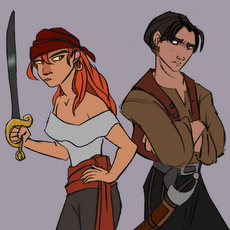Walt Disney Feature Animation (November 27 2002), Walt Disney Home Entertainment (July 3 2012), Blu-ray Disc plus DVD, 95 mins plus supplements, 1080p high-definition 1.66:1 widescreen, DTS-HD 5.1 Master Audio, Rated PG, Retail: $29.99
Storyboard:
Young Jim Hawkins is your usual Disney loner, although this time around he happens to live on an isolated spaceport with his Mom. One night, their popular Benbow Inn boarding house’s landing zone is crashed into by a dying alien, who warns Jim to “beware of the cyborg”. The advice later makes new sense to Jim after he has found a legendary treasure map among the alien’s possessions, pointing to a planet on the farthest reaches of the galaxy. A crew is recruited to take them there but one of these new ship mates is John Silver, part man-part robot – could this be the cyborg Jim was warned about?

Over the course of the voyage, Silver and Hawkins become close, as Silver’s charm and persuasive nature brings a father-and-son angle to the plot. But Jim discovers too late that all is not what it seems with Silver and the rest of the crew, when the cyborg stages a mutiny. Jim’s quick thinking saves his immediate friends and their eventual escape leads them to the fabled planet of stolen treasures. However, unknown to Hawkins, Silver is hot on their trail, setting the stage for a very expensive showdown, during which Jim must choose between his head and his heart, and Silver must decide whether the gold is worth dying for…
The Sweatbox Review:
Despite its underperformance at the American box office, Disney fans like myself were very pleased that in Treasure Planet, the Studio’s 43rd animated extravaganza – coming to upgraded Blu-ray Disc concurrently with the Studio’s next film, Home On The Range – they were thoroughly entertained, surprised and thrilled by the film, and this latest disc incarnation is pretty much guaranteed to repeat that experience. Directors John Musker and Ron Clements had been trying to get their epic retelling of Robert Louis Stevenson’s “Treasure Island-in-space” mounted at Disney for almost 20 years. A dream project for the pair, it was first mooted as way back as production on The Black Cauldron (1985) wound down.
The duo were soon at work on the Studio’s next feature, The Great Mouse Detective (1986), with that film’s use of computer graphics urging the two to ask for development on their Treasure idea. Then-Disney honcho Jeffrey Katzenberg told them that no one would pay to see another Treasure Island story, especially one told in outer space, and the pair were put to work on the Studio’s big “comeback” movie The Little Mermaid (1989). Of course, that film was a smash hit and really confirmed the renaissance of Disney Animation, with Musker and Clements assuming that they would then be allowed to pick and choose their next project.
In a way they were: Katzenberg offered them either Aladdin or The Lion King, but with still no sign of a greenlight for what the two were now calling Treasure Planet. Aladdin, of course, opened to huge acclaim and even bigger box-office in 1992, and at this point Katzenberg could not very well hold the blockbuster duo back from chasing their dream project. They worked a little on developing the film during the 90s, with Katzenberg issuing them an ultimatum: deliver the Studio one last blockbuster “event” picture, and Treasure Planet had a greenlight. The two turned to Greek mythology, turning the story of Hercules on its head in 1997 with a wickedly funny musical comedy.
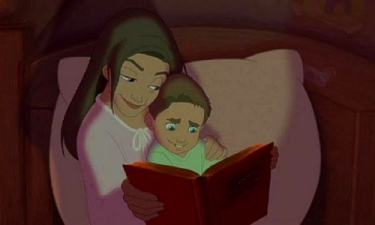
By this time, Katzenberg had left Disney to found his own animation studio, DreamWorks, although John and Ron remained true to their word and continued with the Hercules project, which although wasn’t the kind of critical and commercial success the earlier films had enjoyed, still did turn out to be another $100m hit for Disney. Although Katzenberg was gone, the animation brass was good to his word, and the two directors did finally receive their own reward: Treasure Planet was “a go”. Perhaps the film languished in “development hell” for too long, or perhaps when the directors finally got the go ahead, the story had either been revisited and revised too many times or conversely gotten lost in the attention to visual detail, because Treasure Planet does feel a little less coherent in places than it might have done.
To be fair, the screen audience really was not clambering for yet another version of Stevenson’s classic tale, and pirates were still, pre-Johnny Depp, box-office poison, so the decision to set the action in space was not only brave, but a much needed change of scenery. It does actually work rather well, fusing the 18th Century look of the sets and costumes with a 28th Century idea of real space ships, with all the sci-fi trappings one might expect (laser cannons, turbo-powered time-warp engines, etc). Basically the film does exactly what it sets out to do with its “Treasure Island-in-space” manifesto, providing a fairly reasonable transfer of Stevenson’s book to the screen. Visually the film is truly stunning, with grand vistas and softly-lit characters that return to the deep and lush style of Disney animation missing since The Hunchback Of Notre Dame and Tarzan, with those wonderful settings that one could almost step in to.

I did feel a tendency towards the over use of 3D computer generated backgrounds however: while put to good use in Aladdin’s trip through the Cave Of Wonders, or Hercules’ battle with Hades, here the camera swirls around quite often, perhaps in an attempt to compete with the then-emerging CGI films, and the moves are not as precise as those we are accustomed to now. This is obviously a directorial choice, as it does help put the audience and the chased characters in peril, but it’s a trick used a few times too often and coupled with the quick cuts, it can pull you out of the movie for a few moments. Otherwise the attention to detail and the melding of 2D and 3D elements is exemplary. The ships are naturally CGI rendered, and do look as such, but somehow they do fit into this hybrid world.
Props and some other characters (B.E.N. the Bio Electronic Navigator, voiced by Martin Short playing the token shouting character in a modern Disney movie) are very well handled, and Morph, pirate Silver’s parrot-substitute, is a clever addition, rendered nicely with a semi-transparent look. Of the leads, I found Jim Hawkins to be a little stiff first time around, and I’m not sure if it was a conscious decision to make many of his and his Mother’s hand movements as similar as they are, but the subtlety works either way. There are moments, thanks to Joseph Gordon-Levitt’s voice acting and John Ripa’s animation, that Jim really does come alive, but these are only a few times at pivotal moments in the script, though subsequent viewings, especially in this new HD transfer, did open the character up to me a little more.
The grand behind-the-scenes production experiment on the movie was with John Silver’s character, here made a half-man, half-robot cyborg, with a CGI’d hand and electronic leg. What’s nice is that his character is reflected in the story and in the very making of the film in regards to the way he, as a character, is split between right and wrong, and as a drawing brought to life in two ways. For the “human” side of Silver has been traditionally hand animated by celebrated animator Glen Keane (Ariel, Beast, Aladdin, Tarzan, etc), while his electronic parts have been created, match-moved and animated within the virtual CG environment. This long-way-round approach looks seamless on screen, but does create the feeling that Silver is a man of two halves, exactly the response the filmmakers were looking for.
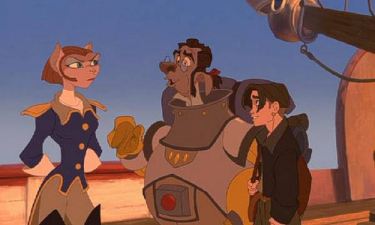
However, perhaps Keane was somehow tied to nailing a performance early on instead of being able to revise as often as he might have, as even Silver does not always come across with Keane’s usually spot-on eye to character, and never really makes much of an impact until the point of mutiny on the ship. The father-and-son spin on the story never really catches on either, until an obviously plotted scene occurs that supposedly cements their relationship. It’s still a little labored, and the final pay off of Hawkins looking off into a Silver-tinged sky doesn’t quite have the warm-hearted feeling it should perhaps have done. By far the most successful of the shipmates is Captain Amelia, voiced by Emma Thompson. I’m not a huge fan usually, but here is a great example of character design and voice being perfectly matched and suited to one another – you’ve never seen a better-looking cat-like alien than Amelia in those boots, I can tell you!
David Hyde Pierce makes a return to the Disney fold with his turn as the dog-like Dr Doppler, a weak but well-meaning father figure to young Hawkins. There’s a little twist between him and the Captain by the film’s end, but this feels like what it is: a late attempt to fit in some kind of love interest sub-plot. But the rest of the film is uniquely all-action, with some nice set pieces and a couple of “narrative montage” songs by the Goo Goo Dolls’ John Rzeznik that do nothing to detract from the story. The inclusion of these songs is what may bring on the stronger feelings of a reminder of Fox’s animated sci-fi attempt Titan AE, but Treasure Planet, to its credit, never feels as squarely aimed at the teenage boys audience as Titan did. Indeed, one could say Ron ‘n’ John’s film was a very romantic approach to a modern animated film, what with it’s marvelously deep and rich color palette, especially.
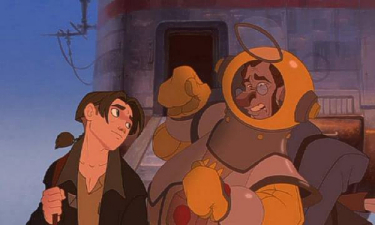
The film’s balance of Stevenson and Jules Verne-like elements also mix better than Titan, as well as topping the Disney Studio’s own Atlantis: The Lost Empire, which Treasure Planet also vaguely resembles, mainly due to James Newton Howard’s memorably big and brassy orchestral score. But if you enjoyed both Titan AE and Atlantis (or even older fare as Starchaser: The Legend Of Orin), then you’ll go big for Treasure Planet, while its softer mix of classic adventure and the futuristic gadgetry will not put those family members off. I have to say I enjoyed it a lot after not having seen it for the past few years, the original DVD viewing and perhaps once or twice on television being about as much as I have seen it.
But it’s always a film that sticks in my mind for a number of reasons, not least the exciting score and the gorgeous visuals: Hunchback and Tarzan aside, Treasure Planet is representative of the epitome of the kind of “tradigital” animation that was perfected by the Studio in the 1990s and early 2000s, and I can’t think of one other feature even from those times that could match the sheer visual invention, solid animation and exquisite production design elements at play here. Unfairly given a poor reputation (much like many of Disney’s last few traditionally animated pictures), Treasure Planet is yet another film that warrants and deserves a reappraisal, something that this astonishing Blu-ray effortlessly offers as it blasts off for a stunning animated adventure.
Is This Thing Loaded?
Don’t throw out the DVD! Much like the concurrent release of Home On The Range, Treasure Planet pleasingly manages to pull over most of its previous DVD’s roster of supplements to its Blu-ray counterpart – with some frustrating exceptions. Although, again like that disc, these are not the expansive kind of extras viewing that graced the lavish two-disc sets of old and some of the original disc’s navigational elements have been reduced to simpler options, there is still a more than healthy, and sometime surprising, amount of material to badge the title as a 10th Anniversary Edition, something the Range BD goes without even though it merits a similar Special Edition designation.
Disney’s usual bunch of Sneak Peeks (also optional from the Menu) is naturally in effect from when the disc spins, which here mirror other current releases to include a couple of Disney promos and Blu-ray previews for the Cinderella Diamond Edition, Lady And The Tramp II: Scamp’s Adventure, Tinker Bell’s Secret Of The Wings, the Pocahontas and The Rescuers 2-Movie Collections, The Tigger Movie, The AristoCats, Planes, and the too-Forrest Gump, too-quirky, too obvious Oscar-bait The Odd Life Of Timothy Green, already annoying before anyone really knows much about it.

Moving onto the bonus features, it would have been very fun to see the Treasure Planet DVD’s supplemental presentation – which pioneered the kind of video-added extras that Disney’s Blu-ray titles initially promised – ported over intact here, making this new disc feel bang up to date, but the promoted Blu-ray Visual Commentary track is a no-show here. For that you’ll have to turn to the enclosed standard definition DVD – an exact duplicate, save the new trailers, of the 2003 disc – where you’ll find a star field map that serves as a menu to the options on offer, allowing selection of the various bonuses, the discovery of others as you travel through the movie, or to pick them purposefully from a chart, although I couldn’t notice any real discernible differences between them.
The included DVD actually remains the better authored platter, offering up a THX Optimizer for adjusting your display to best show the movie and, to the right of the THX logo in the Set-Up menu, a hitherto invisible film clapperboard will show up, linking to credits for this DVD (and revealing the more than capable Disney team of Jeff Kurtti and Michael Pellerin are behind most of the material on offer; the DVD is also officially labelled a Special Edition here too). It’s on the DVD that you’ll find the Visual Commentary itself – a crying shame that its presentation hasn’t been re-encoded for the BD. This approach offered a new way, at the time, for an audience to experience a movie and its production, but is by no means recommended to watch before you’ve seen the movie proper, as the constant interruptions break the flow of the film.

Here, we’re introduced (in a very amusing clip) to directors Musker and Clements and their producer Roy Conli, who explain that during the movie the standard audio commentary will occasionally lead into a short video clip that will explain the process of creating the scene you are viewing. When the clip is done, the film will return to the exact same point it left off and the commentary will continue. It’s a great track, and the trio are occasionally joined by Glen Keane and various crew, so there are hardly any lulls or dead audio. There’s much to learn and be impressed by in the level of detail each artist brings to the table, but Blu-ray fans needn’t be too alarmed: all of the clip material that features in this extended presentation does also turn up on the HD disc, merely served up in the Bonus Features menu as individual entries.
On the Blu-ray Disc, the filmmakers’ remarks are offered as an Audio Commentary instead, severing the inserted video clips and saving them for the grouping of extras (as they were, to be fair, also on the DVD). As with the concurrent Home On The Range BD, the Commentary isn’t bunched logically with the other extras, but is nevertheless where fans of the movie should start in exploring its production. At first glance, and after getting over the disappointment of not finding the Visual Commentary, you may be scratching your heads in frustration at it possibly be missing too, but rest assured that it is here: you’ll find it in the Set-Up language options, although selecting it won’t launch the movie…you need to then go back to the Main Menu to play it – oy!

In the true Bonus Materials section, you’ll find a series of Introductions by actress Laurie Metcalf, who voices Jim’s Mom in the movie. Seemingly shot, but not used, for the 2003 DVD (the material is 4:3 letterboxed and she references “Walt Disney Feature Animation” when it would be “Walt Disney Animation Studios” in content shot today), these are technically “new” to the BD edition but remain, as do all the supplements, in standard definition. In place of the Visual Commentary, she acts as something of a guide, preparing us for each of the following groupings of behind the scenes material, all of which, while only SD, looks pretty darned good and noticeably better than the DVD in terms of the AVC compression allowing more bandwidth to the clips.
The (geddit?) RLS Legacy Virtual 3D Tour (the DVD’s Treasure Hunt option – which features an additional deleted scene – can still be found there) offers a Technical and Nautical tour of the ship, as well as the DVD’s only game. Presented very good looking widescreen, the tours are pretty nice, with newly rendered views of the ship and a narrated “walk-through” of the decks that gives the viewer enough time to take in what is being said and shown. This 11-minute look is also chopped up into 33 sub-chapters, so the viewer can always skip onto the next detail quickly. Both tours replay the same footage, with the Technical version pointing out the way the scenes were put together and the Nautical voice over explaining the geography and purpose of each prop and machine (this second version, for some reason on the BD, cutting out at just over the seven minute mark).

DisneyPedia: The Life Of A Pirate Revealed is a kids’ look at Pirate lore, although adults may get a kick out of guessing the names of the many films the clips come from – I noticed Blackbeard’s Ghost, Swiss Family Robinson, Pinocchio, Pocahontas, The Little Mermaid, Fantasia, In Search Of The Castaways, Sleeping Beauty, Aladdin, Ichabod And Mr Toad, Peter Pan and Treasure Island among the Disney ones, and even some early Mickey and the Pirates Of The Caribbean ride get a look in (though strangely no tie-in mention of that film)! Split into six sections, there is a “play all” feature that runs through them all, creating a 12-minute program, including some credits.
The Roy Disney-hosted Disney’s Animation Magic is our first peek behind the scenes. I think what Roy did for both the Disney animation side of the company and for the company in general was great and is still overlooked, but his work here looks stilted and he doesn’t come across as well as Walt did on his TV show, or even Roy himself in previous disc appearances. That aside, this is an interesting 14-minute watch for casual viewers since things don’t get too technical, as well as those who understand the process. It loses marks for the almost-comical use of the Disney’s Animation Magic ident that flashes on every time Roy mentions those three words, for the blatant advertising of Don Hahn’s book of the same name, and for ultimately being made up of clips from other sections of the disc, so the viewer may bump into the same material a couple of times along the way.

More enticing is a small six-minute-plus selection of Deleted Scenes, again intro’d by Metcalf, although in practice these only amount to little more than alternate versions of the main prologue and end sequence. The three scenes are introduced by the directors and are a mixture of pencil test, storyboard and completed animation. Best of all is Jim Meets Ethan, a sweet little scene that puts the accent on Jim’s need for a father and opens his character up a lot more, and it’s a shame this was not kept in. Remember that collecting the eight map spheres in the DVD’s game unlocks an extra scene (in final color), pretty much worthwhile going through the game to reach but frustrating that it wasn’t simply added to the listed selection on this BD.
Metcalf again appears in an intro to a Story section, the only other inclusion being the theatrical trailer for Treasure Island, Walt’s own live-action take on the story back from 1950 (and – come on! – just where is this and other live-action gems from the Studio on Blu-ray Disc!?), served up as a tenuous but welcome way to remind us of the original Stevenson book. In Music, Metcalf looks briefly at Newton Howard’s score before moving on to John Rzeznik’s (forever to be known as “John Rzeznik of The Goo Goo Dolls”) contribution, followed by the video promo for I’m Still Here (Jim’s Theme). Presented letterboxed, the song is as good as anything else in this style, and the clever and expensive looking effects-packed video is very well made, not relying on too much footage from the film as many of these clips often do. With the intro, Music lasts a worthwhile five and a half or so minutes.

Art Design, again intro’d by Metcalf, serves up the two and a half minute The Brandywine School, which looks at the design of the film, its reflection in the storybook artists of old and the reasons behind the choices the production went for. The one and a half minute 70/30 Rule highlights the unique decision by the directors to bring a 70 percent traditional feel and a 30 percent futuristic style to the overall film, from the look of the ships, the design of Silver and the audiences’ perception of the use of CG in the completed movie.
Metcalf again intros The Characters, with John Silver and the B.E.N. robot both having their roles explored more deeply. The “Hook” Test shows Glen Keane’s original paring of Silver’s cyborg arm combined with another famous Disney pirate, Captain Hook, to see if the combination of traditional and CG animation within a single character was technically and emotionally feasible. CG animator Eric Daniels explains more, also providing the first Silver Arm Test CG test. For B.E.N. there’s another intro, plus 3D Character/2D World, a video clip that includes early tests and the reasons behind the decision to make B.E.N. a CG character, while the three-minute Maquettes treats us to a cut-down version of a very cool look at how computers also played a part in creating the statue of John Silver that aided the animators in drawing the character the same way from different angles.
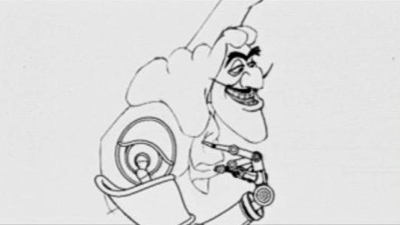
Next, in Animation, we’re offered a fun Metcalf intro and a one-minute look at the design for Delbert Doppler by animator Sergio Pablos, showing some early pencil tests, while Silver Progression Animation shows the creation of a scene by Keane, from storyboard, through rough pencil and final animation, with emphasis on showing off the blend of 2D and 3D CG enhancements. Pencil Animation offers a peek at some early designs for Captain Amelia, and there’s also a Rough Animation To Final Film Comparison (as opposed to the usual storyboard comparisons) that shows up how much performance the animators get into their drawings.
It’s a real pity that each section doesn’t have a Play All option, especially in Dimensional Staging, which has several snippets only lasting not much more than a minute apiece. Effects Animation looks at the environments and prop effect shots of the movie, but all too briefly, while Pose Camera does the same thing with the process of combining a 2D hand drawn character within a 3D computer generated model, showing pencil tests, and a sequence breakdown. Layout Demonstrations is another short clip, taking us through three virtual backgrounds.
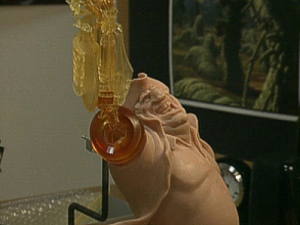
In the same section, Treasure Planet Found explores the core of the title world, from rough animation and animatics, to the CG design and the thinking behind the design of the starfield map that would lead young Jim there. Lighting rounds the section up and takes a look at the use of Deep Canvas, the Studio’s virtual painting technology, in Treasure Planet and how the lighting in a scene can affect the mood and texture of what happens on screen. It’s always nice to see this early concept stuff and it’s a shame there isn’t more, but you still get a fair share and in much more detail than would normally be included in a half-hour “making of”.
Closing this collection of supplements is a rarity on Disney discs in general: Release, which actually retains some publicity for Treasure Planet in the form of the original Teaser Trailer (with that great John Williams score from Far And Away), and the full Theatrical Trailer (that really does echo the ads for Titan AE), as well as a final intro from Laurie Metcalf. While the Blu-ray does bring some new elements to the table in the form of Metcalf’s introductions, it also drops some sections from the previous DVD, most notably several Art Galleries that allowed a look at hundreds of development works, paintings and moments from the finished film, an additional 27 storyboards and concept art images, in-depth development art for several leading and secondary characters in the film, and poster art.
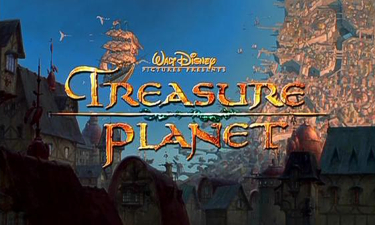
Thankfully, Disney hasn’t chosen to re-author the original disc, meaning that all those elements and more can still be found on the enclosed DVD. While this means the images haven’t been upgraded to HD, they were unlikely to have been on the BD anyway and, while that is a shame, it’s nice to see that the Studio hasn’t shipwrecked a title they could so easily have done. Essentially, the combination of “archive” DVD and this new presentation does a great job of preserving the film’s production.
Case Study:
Following the tack sported by its Home On The Range counterpart, Treasure Planet comes to Blu-ray in traditional Disney packaging: that is in basically repeating the previous DVD’s cover art but placing it within the blu-rimmed slipcovers that the Studio favors. The effect works well, with the title even given a 10th Anniversary label that works well in both retrospect of the film’s theatrical release and in its including the almost ten year old DVD edition too. A four-page DVD Guide hasn’t been carried over, but the embossed slipcover is nice and substantial, even if the back-cover blurb is as inconsequential as they come, while Disney’s new stance on catalog disc art stands in the plain blue BD and the silver-gray DVD. A front cover sticker promotes the film’s 2001 Best Animated Feature Oscar nomination: probably not really a reason casual viewers might pick it up but it’s good to see the Studio seemingly proud of the movie’s achievement, and at under $30 – the cost of just the original DVD – one can’t complain about the value of this double disc HD package.
Ink And Paint:
I originally saw Treasure Planet late in its theatrical run, by which time the print I saw was badly damaged and scratchy, with printer marks running down the right hand side of the frame throughout the entire film (I was hoping that they would disappear after the first reel, but alas they stayed). After poor opening numbers, it really did seem Disney had just dumped the film on screens using bargain basement prints that had not even been checked prior to shipping out. Which makes it all the more pleasing that Treasure Planet on Blu-ray looks absolutely stunning; a usual complaint from me is that digital editions of animated films can look too clean, but here the visuals are so deep and lush that the higher resolution only allows for them to be appreciated all the more. A crisp and correct 1.66:1 digital transfer creates depth and hues that the film print I saw never had, with color that is rock solid but not saturated.
I love the deep blues that Disney (and in particular the films of Musker and Clements) get into their films, and Planet has some exceptional night-time scenes to marvel at. In the multi-shaded imagery, there are some hints of color banding here and there, but there is so much happening in Treasure Planet that it actually makes an HD transfer essential, really bringing the film and its world to life in a new way, bringing attention to background elements and additional touches that I didn’t see on the big screen or the previous DVD. Even after ten years this is still certainly demo quality material for those that like their tradition animation a little future retro – this is the certainly the kind of animated film Blu-ray was invented for!

Scratch Tracks:
Not only because of the simply awful print I saw theatrically but also since I originally endured seeing Treasure Planet with a bunch of kids at an afternoon screening, the theater sound system did not seem to me to be pumped up to its usual wattage, perhaps mindful of doing any damage to those tiny ears (how times have changed: the recent showing of The Amazing Spider-Man, also full of kids, was an ear-splitting experience). What I do love about seeing films with children is the awe and wonder in their faces as they see the most remarkable sights and hear the most amazing sounds. I remember many a “wow” and gasp coming from the seats behind me, and my friend’s then-four-year-old son was transfixed. The lack of audio punch didn’t detract from my original enjoyment of the film, but I was still hoping for a little more push when the big action sequences kicked in.
However, in a good home theater set-up, the movie really comes to life for a ten year old 5.1 track, the surrounds forced into overtime action as ships swirl around in the air and zoom past the listener. James Newton Howard, in the midst of something of a mini-Disney career between composing other tent pole pictures for the Studio around this time, again scores big (pun intended!) here, with an atmospheric and totally engrossing musical accompaniment. The uncompressed DTS sound on this disc, as deep and rich as the pictures it is matched to, reproduces his orchestra with a fully enveloping experience, while not forgetting the thrills of deep bass rumbles, spacey strings, and the importance of crystal clear dialogue – first class!
French and Spanish dubs ‘n’ subs are bundled in, as well as those in English, but as a side note, in checking that the foreign dubs were intact, I noticed that although the French language version retains the Rzeznik songs in English (including Always Know Where You Are, which was covered by BB Mak on the soundtrack album), the Spanish dub features a completely different song (in Spanish) over the end credits, before Rzeznik’s song plays out right at the end instead of the original score – a “cheeky” extra for the curious!
Final Cut:
Originally a very respectable special edition, I’m very pleased to say that Disney hasn’t taken the easy option and simply dumped the movie out without bothering to draw on its existing DVD supplements. A much needed Play All option here would have helped disc navigation (where’s B.E.N. when you need him!) but some “new” content is nice and considering the Studio’s previous lack of support for this title after its initial box-office disappointment this kind of treatment certainly can’t be knocked! A beautiful digital widescreen transfer is expected, and the existing extras, both on the BD and included DVD, are about as comprehensive as needed. Simply put, given Treasure Planet’s production and release history, one might have understood a distinct lack of extras, as some of Disney’s more recent BDs have attested (the otherwise redundant “20th Anniversary” Rocketeer, anyone?). As it turns out, Treasure Planet couldn’t get a lot better than this in HD!
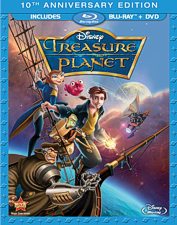 | ||
 |









